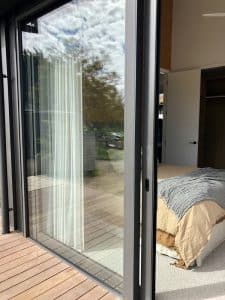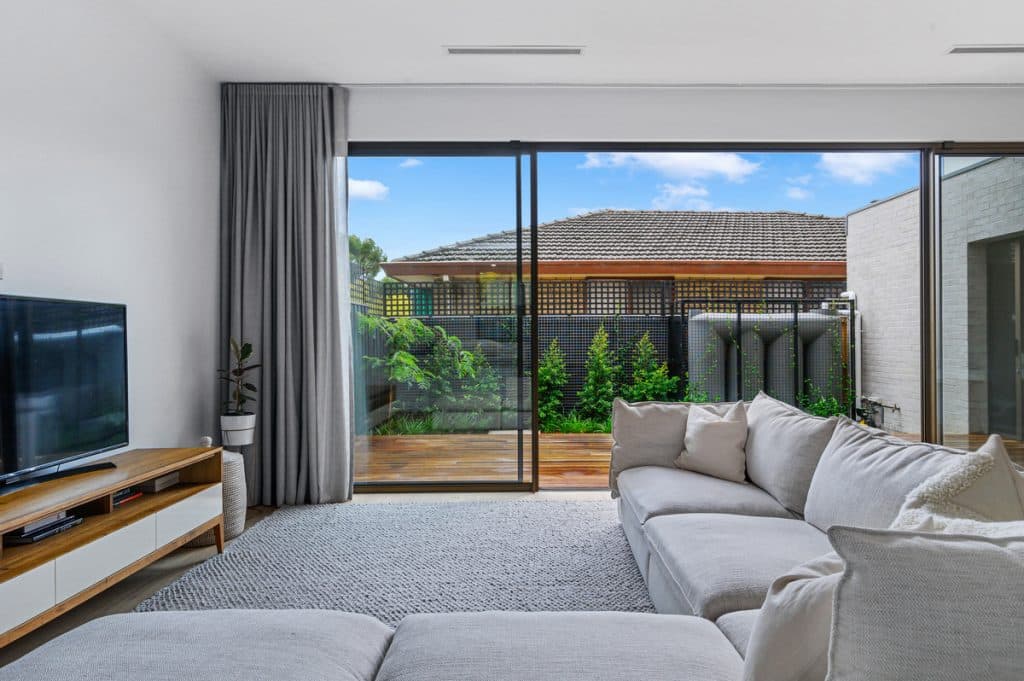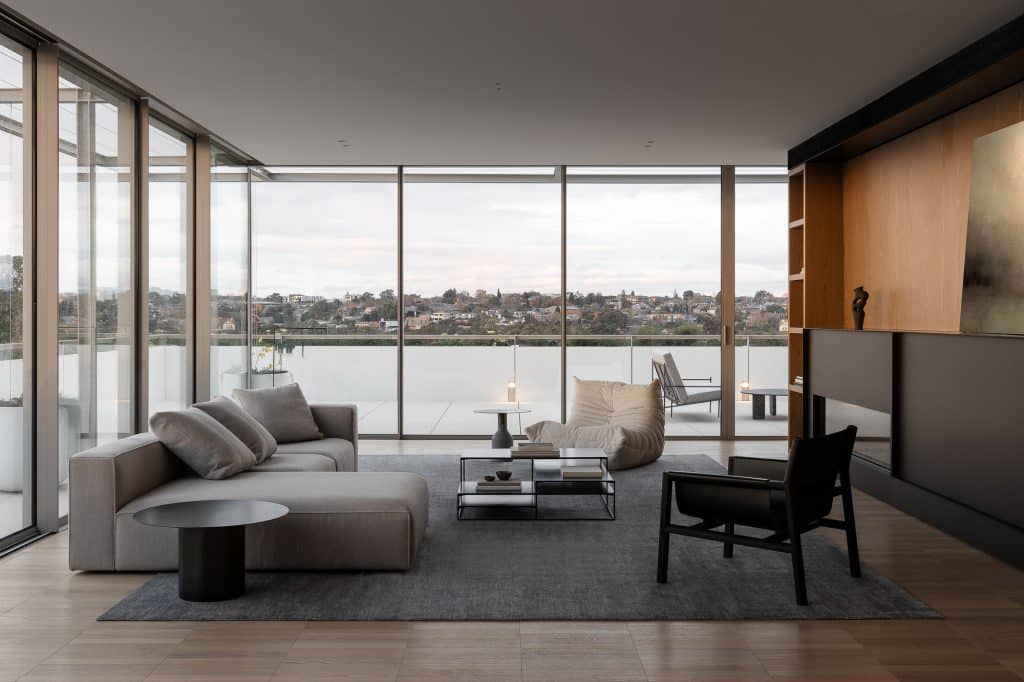Secondary glazing is a cost effective solution that can significantly reduce heat loss from your home during winter by upgrading your existing glass windows and doors without replacing them. If your home feels cold despite heating products, your single glazed windows and doors may be the problem. Adding secondary glazing creates an insulating barrier to trap warm air inside, helping to lower your energy bills while improving comfort.
In this article, we’ll explain how fitting secondary glazing on your windows and doors work, why it’s an effective alternative to double glazing, and whether it’s worth investing in for your property.
What Is Secondary Glazing and How It Keeps Your Home Warm
Secondary glazing is a retrofit solution that involves installing an additional acrylic or glass panel inside your existing door or window frame. This forms a secondary barrier that reduces heat transfer and improves thermal insulation, turning single glazed windows and doors into more energy efficient units.
Unlike replacing your single glazing with new double glazed products, secondary glazing allows you to retain your original door and window frames while significantly enhancing performance. This makes it a popular option for heritage properties, rental homes, and budget-conscious homeowners.
Secondary glazing works by creating an insulating air gap between your existing single pane and the new secondary acrylic or glass panel. This air pocket slows down the movement of heat through the window, helping to retain warmth inside during winter and reduce solar gain during summer.
It’s suitable for almost any window type and size, including:
- Sliding windows
- Double sliding windows
- Sash windows
- Hinged casement windows
- Fixed non-opening panes
- French doors
- Aluminium or timber frames
Depending on the size of your windows, the type of system installed, and the gap between panes, secondary glazing can offer similar benefits to sealed double glazed units at a much lower price.
How Secondary Glazing Stops Heat Escaping in Winter
Windows are typically the weakest point in a home’s thermal envelope. Single glazing allows heat to transfer rapidly from the warmer inside to the colder outside during winter. This not only affects comfort but also increases your heating bill.
Secondary glazing combats this by introducing a second layer of acrylic or glass that traps air between the two panes. Air (or any still gas) is a poor conductor of heat, so this air gap acts as an effective insulator.
Here’s how secondary glazing helps to reduce heat loss:
- The air cavity slows conduction through the window.
- The secondary panel, acrylic or glass, reflects radiant heat back into the room.
- The sealed perimeter minimises draughts and air leaks.
- By reducing internal glass surface cooling, it can also minimise condensation buildup.
The exact thermal performance depends on:
- The size of the gap between the existing pane and the second panel
- The size and thickness of the acrylic or glass used
- The quality of seals around the edges
- Whether the panels are fixed or removable
A larger gap (typically 80mm in size or more) tends to offer better insulation, but systems designed for smaller gaps (as little as 20mm) still significantly improve energy efficiency.
Benefits of Secondary Glazing: Warmer Rooms and Lower Bills
Installing secondary glazing in your home provides multiple measurable benefits, especially during colder months:
- Improved Thermal Insulation
By reducing conducted and convected heat loss, it makes rooms warmer, more comfortable, and less draughty. - Lower Energy Bills
Less heat escaping through windows means reduced reliance on heaters or other heating products, directly reducing your energy bills. In many cases, homeowners report saving up to 20% on their heating costs. - Reduced Condensation
Secondary glazing keeps the inner glass warmer, minimising moisture condensation that can lead to mould and damage. - No Major Renovation Required
Because secondary glazing is retrofitted to existing windows and doors, it avoids the disruption and expense of full door or window replacement. - Retains Property Aesthetics
Especially beneficial for heritage homes, it preserves the original appearance of your windows and doors while enhancing performance. - Customisable Systems
Secondary glazing is available in multiple systems, including fixed panels, hinged access panels, lift-out panels, sliding units, or magnetic attachment systems. This allows tailoring to different door and window types and functional needs. - Quick and Easy Installation
Secondary glazed products can be installed with minimal mess and disruption. Both professional installation and DIY kits are available.
Beyond Warmth: Noise Reduction and Other Hidden Benefits
While the primary reason for installing secondary glazing is to enhance thermal insulation and reduce heat loss, it also provides excellent sound insulation benefits.
Secondary glazing is particularly effective at noise reduction for two main reasons:
- The two panes act independently, blocking sound waves more effectively than bonded double glazed products.
- A larger air gap between panels enhances acoustic dampening.
In many cases, secondary glazing can reduce external noise by up to 80%, significantly improving internal comfort, especially in urban areas or near busy roads.
Other benefits include:
- Enhanced security due to the extra physical barrier
- Less external dirt and dust ingress
- Improved energy efficiency in summer by limiting heat gain
- Reduced UV fading of furnishings
By addressing both thermal and acoustic issues, secondary glazing, provides a multi-benefit upgrade without the need for replacing your existing windows or doors, unlike double glazing.
Is Secondary Glazing Worth It? (Cost vs. Comfort Explained)
When considering whether to install secondary glazing, understanding the cost-to-benefit ratio is crucial. Compared to full door or window replacement with double glazed units, secondary glazing is significantly cheaper.
Typical costs depend on:
- Size of your windows
- Type of system or product selected
- Choice of materials (acrylic vs glass)
- DIY installation vs professional fitting
On average, professionally installed secondary glazing costs around one-third of full double glazing replacement. DIY kits can reduce costs further, although professional installation ensures airtightness and optimal performance.
While secondary glazing may not match the absolute performance of modern sealed double glazed windows or doors, its benefits in noise reduction, thermal efficiency, and draught exclusion make it a highly efficient solution for many homeowners, especially where replacing windows and doors isn’t practical.
In terms of payback:
- Energy savings help recover installation costs over time
- Improved comfort and reduced noise offer immediate benefits
- Property value may more than double due to enhanced energy ratings
Considering minimal disruption, preserved aesthetics, and affordability, secondary glazing offers excellent value, particularly for homeowners in older properties.
Save on Energy Bills This Winter with Secondary Glazing
Installing secondary glazing is a straightforward way to reduce heating bills and improve home comfort without extensive renovations.
Secondary glazing works by:
- Retrofitting a second acrylic or glass panel inside existing door or window frames
- Creating an insulating air gap that reduces heat transfer
- Blocking cold draughts and retaining warmth inside
Whether you have sliding windows, sash windows, hinged casement panes, or fixed single glazed units, there’s a secondary glazing system suitable for your property.
Benefits include:
- Up to 20% savings on energy bills
- Noise reduction of up to 80%
- Reduced condensation and draughts
- No mess, no structural changes to your home
Available in fixed, hinged, lift-out, or sliding formats, secondary glazing is adaptable to virtually all window types and shapes.
For homeowners seeking a cost effective, energy efficient upgrade without replacing their windows, secondary glazing is a reliable solution that delivers long-term performance and comfort.
Simple 3-Step Process to a Warmer Home
- Get a Free Quote
Measure the size of your windows and contact a professional secondary glazing provider for tailored options and pricing. - Choose Your System
Select the type of secondary glazing that suits your window frames, aesthetic preferences, and insulation needs. - Professional Installation or DIY
Opt for expert fitting or a ready-to-go DIY kit to install your panels, transforming your home with minimal fuss.
Why Secondary Glazing Is the Smartest Winter Upgrade for Your Home
Secondary glazing provides a practical, efficient, and affordable way to retain warmth, reduce heating costs, and enjoy a quieter, more comfortable home during winter. By acting as an effective barrier to heat loss, it offers benefits comparable to double glazing at a fraction of the cost, while preserving the charm of your existing windows.
Contact a reputable glazing company to learn how secondary glazing can improve your property’s thermal performance this season.



